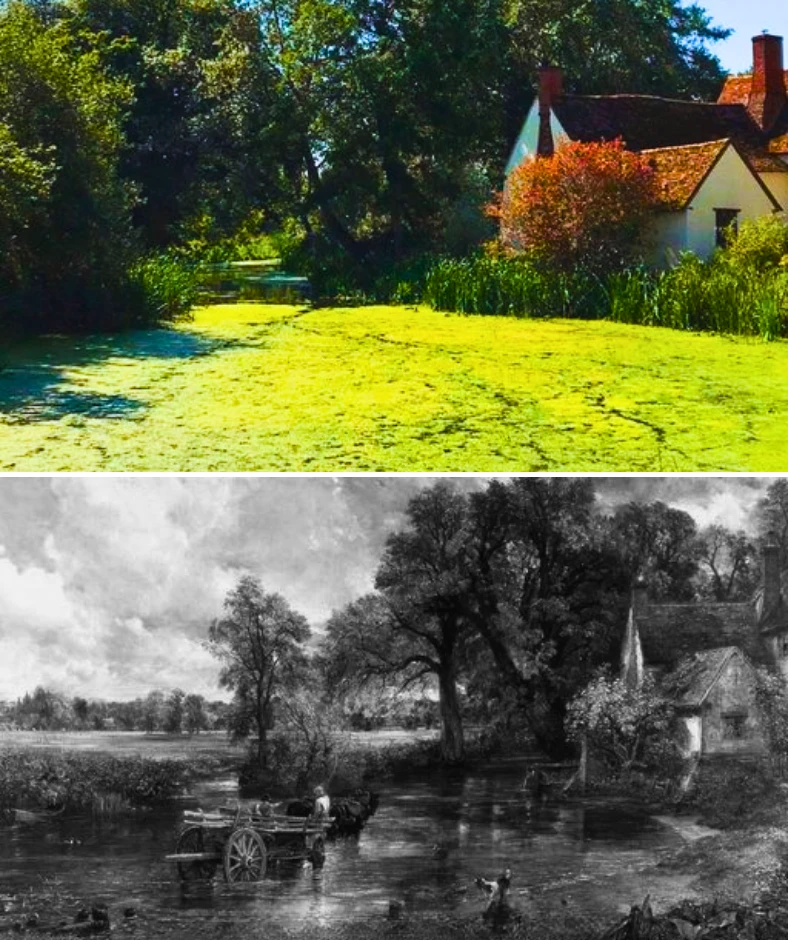Where Constable’s Masterpiece Meets Rural England
Art lovers and countryside enthusiasts, prepare to be captivated! The Hay Wain, a masterpiece by John Constable, isn’t just a painting – it’s a portal to a timeless scene in rural England. This iconic work, housed in London’s National Gallery, depicts a working farm scene bathed in the warm glow of a summer afternoon. But The Hay Wain is more than just a pretty picture. It’s a window into the heart of English agriculture, a celebration of the natural world, and a testament to Constable’s artistic genius. So, before you embark on your journey to explore the real-life inspiration for this iconic artwork, let The Hay Wain ignite your imagination and inspire you to discover the beauty of the English countryside.

5 Must-See Gems Inspired by The Hay Wain:
- The Stour Valley: Head to the heart of Suffolk, where the River Stour winds its way through rolling hills and charming villages. This idyllic landscape, meticulously captured by Constable in The Hay Wain, offers a chance to step into the painting itself. Explore the villages of Flatford Mill (Constable’s birthplace) and Dedham, where you’ll find Willy Lott’s Cottage – the inspiration for the farmhouse in the painting. Rent a boat and meander down the River Stour, or simply relax on the riverbank and soak in the timeless beauty.
- Flatford Mill: This 18th-century watermill, meticulously depicted in The Hay Wain, is now owned by the National Trust. Step back in time and explore the working mill, complete with its giant water wheel and grinding stones. Wander through the surrounding gardens, marvel at the iconic hay wain on display, and imagine the bustling scene of Constable’s era.
- The Bridge Cottage: Located next to Flatford Mill, this charming 17th-century cottage was once the home of a miller and his family. Explore the cottage’s interior, furnished in the style of Constable’s time, and imagine the lives of those who lived and worked alongside the River Stour. Compare historic photos with the present day and witness the enduring character of this picturesque location.
- Christ Church Mansion: This grand 16th-century mansion, located near Ipswich, houses an impressive collection of Constable’s work, including preliminary sketches and studies for The Hay Wain. Delve deeper into Constable’s artistic process and gain insights into his use of light and color. The mansion itself is a masterpiece, boasting beautiful gardens and a fascinating history.
- The National Gallery, London: Of course, no journey inspired by The Hay Wain is complete without seeing the masterpiece itself. Head to the National Gallery in London and stand in awe of Constable’s genius. Admire the intricate details, the play of light and shadow, and the sense of tranquility that emanates from the canvas. Compare historic photos of the painting with the present day, appreciating its enduring power to transport viewers to another time and place.

Frequently Asked Questions:
- When is the best time to visit the Stour Valley? Spring (April-May) and autumn (September-October) offer pleasant weather for exploring the countryside. Summer (June-August) boasts sunshine and longer days, but expect larger crowds.
- How do I get to the Stour Valley? The Stour Valley is easily accessible by car or train from London and other major cities. Public transport options within the valley are limited, so renting a car is recommended for exploring the charming villages and countryside freely.
- What else is there to do in the Stour Valley? Explore the nearby town of Sudbury with its historic center and art galleries, take a guided walk along the Constable Trail, or enjoy a relaxing afternoon punting down the River Stour.
- Is the Stour Valley family-friendly? Yes! The region offers plenty of activities for families, including exploring Flatford Mill, picnicking in the scenic countryside, and hiring a boat to explore the River Stour.
- What’s the story behind The Hay Wain? The Hay Wain depicts a working farm scene on Constable’s family estate. He painted several versions of the scene, highlighting his love for the rural landscape and his commitment to capturing the essence of everyday life in Suffolk.
